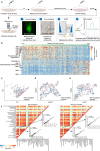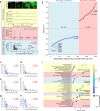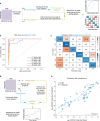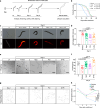Integrative single-cell metabolomics and phenotypic profiling reveals metabolic heterogeneity of cellular oxidation and senescence
- PMID: 40113759
- PMCID: PMC11926267
- DOI: 10.1038/s41467-025-57992-3
Integrative single-cell metabolomics and phenotypic profiling reveals metabolic heterogeneity of cellular oxidation and senescence
Abstract
Emerging evidence has unveiled heterogeneity in phenotypic and transcriptional alterations at the single-cell level during oxidative stress and senescence. Despite the pivotal roles of cellular metabolism, a comprehensive elucidation of metabolomic heterogeneity in cells and its connection with cellular oxidative and senescent status remains elusive. By integrating single-cell live imaging with mass spectrometry (SCLIMS), we establish a cross-modality technique capturing both metabolome and oxidative level in individual cells. The SCLIMS demonstrates substantial metabolomic heterogeneity among cells with diverse oxidative levels. Furthermore, the single-cell metabolome predicted heterogeneous states of cells. Remarkably, the pre-existing metabolomic heterogeneity determines the divergent cellular fate upon oxidative insult. Supplementation of key metabolites screened by SCLIMS resulted in a reduction in cellular oxidative levels and an extension of C. elegans lifespan. Altogether, SCLIMS represents a potent tool for integrative metabolomics and phenotypic profiling at the single-cell level, offering innovative approaches to investigate metabolic heterogeneity in cellular processes.
© 2025. The Author(s).
Conflict of interest statement
Competing interests: The authors declare no competing interests.
Figures








References
-
- Cheng, S. et al. Single-Cell RNA-seq reveals cellular heterogeneity of pluripotency transition and X chromosome dynamics during early mouse development. Cell Rep.26, 2593–2607.e2593 (2019). - PubMed
MeSH terms
Grants and funding
- 32225020/National Natural Science Foundation of China (National Science Foundation of China)
- 32430045/National Natural Science Foundation of China (National Science Foundation of China)
- 32121002/National Natural Science Foundation of China (National Science Foundation of China)
- 32322033/National Natural Science Foundation of China (National Science Foundation of China)
- 32471080/National Natural Science Foundation of China (National Science Foundation of China)
LinkOut - more resources
Full Text Sources
Other Literature Sources

